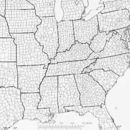More info for the terms:
cone,
natural,
presence,
selection,
treeHarvest methods that are recommended for Fraser fir include shelterwood
or group selection; single tree selection may also be feasible [
2].
Fraser fir is subject to windthrow [
2].
Diseases and infesting agents of Fraser fir include various heart rots,
root rots, and the twospotted spider mite. The worst problem, however,
is the introduced balsam woolly adelgid, which weakens trees and makes
them more susceptible to attack by other agents [
2]. Infestation by
balsam woolly adelgid was first noted in North Carolina in 1957.
Extensive mortality caused by balsam woolly adelgid infestations has
been noted since the 1960's; a large number of mature Fraser fir have
died as a result of this infestation. Many seedlings and saplings have
been killed or growth suppressed [
10], although young Fraser fir have
not been found to support reproducing adults (early instar stages only)
[
22]. Dominance of red spruce and birch (Betula spp.) increases in
spruce-fir stands in North Carolina that have been damaged by this pest
[
8]. The continuing presence of Fraser fir in natural forests will
depend on a complex of survival, growth, and new reproduction. Current
seedlings will need to survive infestations, compete with a dense
understory of smooth blackberry, and reach reproductive age and height.
At present, seedlings are infested but appear to be overcoming the
effects. Smooth blackberry reduces the early survival of Fraser fir
seedlings, and decreases the number of suitable microsites for seedling
establishment [
22].
In some areas high levels of fir recruitment occur after balsam woolly
adelgid infestations [
8].
Nitrogen fertilizers may enhance cone production. One study determined
that although nitrogen does appear to increase cone production, it is
usually not the limiting nutrient; phosphorus and magnesium are the most
limiting to cone yield [
1].

